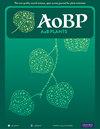Near extinct Argyreia versicolor and rare Argyreia mekongensis are dependent on carpenter bee pollinators
IF 2.4
3区 生物学
Q2 ECOLOGY
引用次数: 0
Abstract
Argyreia versicolor (Kerr) Staples & Traiperm and A. mekongensis Gagnep. & Courchet are extremely rare plant species. The former had not been seen for nearly 100 years, until two individuals were found in Thailand in 2018, and only a handful of populations are known for the latter. The aims of this study were to examine the breeding systems of A. versicolor and A. mekongensis using pollination experiments and to determine their potential pollinators via floral observations. Our controlled pollination experiments uncovered the self-incompatibility of both species. Pollinator censuses indicated that females of two carpenter bee species, Xylocopa aestuans and X. latipes, were the predominant floral visitors for both Argyreia species. Our observations confirmed a harmonious match between the floral shape of both Argyreia species and the body sizes of these pollinators, ensuring effective pollen transfer and validating their role as putative pollinators. In line with the high frequency of pollinator visits observed, our controlled pollination experiments found no evidence of pollen limitation under field conditions. The findings of this study hold significance for the conservation of these endangered species, yet the situation is dire for A. versicolor, with one of the two individuals under study recently lost. Hence, it is crucial to intensify monitoring efforts for the species, aiming to identify additional individuals for potential inclusion in an ex-situ conservation program. Simultaneously, safeguarding the habitat of these plant species and their pollinators will be critical.濒临灭绝的 Argyreia versicolor 和稀有的 Argyreia mekongensis 依赖于木匠蜂授粉
Argyreia versicolor (Kerr) Staples & Traiperm 和 A. mekongensis Gagnep. & Courchet 是极为罕见的植物物种。前者已有近百年未见,直到 2018 年才在泰国发现了两个个体,而后者目前已知的种群数量也屈指可数。本研究的目的是利用授粉实验研究A. versicolor和A. mekongensis的繁殖系统,并通过花卉观察确定其潜在授粉者。我们的受控授粉实验发现了这两个物种的自交不亲和性。传粉昆虫普查表明,两种木匠蜂(Xylocopa aestuans 和 X. latipes)的雌性是这两种姬松茸的主要花访客。我们的观察证实,这两种 Argyreia 植物的花形与这些传粉昆虫的体型相匹配,从而确保了花粉的有效传递,并验证了它们作为假定传粉昆虫的作用。与观察到的传粉昆虫的高频率造访相一致,我们的受控授粉实验也没有发现田间条件下花粉受限的证据。本研究的发现对保护这些濒危物种具有重要意义,然而,A. versicolor 的情况十分严峻,研究中的两个个体中最近就有一个消失了。因此,加强对该物种的监测至关重要,目的是发现更多的个体,以便将其纳入异地保护计划。同时,保护这些植物物种及其授粉者的栖息地也至关重要。
本文章由计算机程序翻译,如有差异,请以英文原文为准。
求助全文
约1分钟内获得全文
求助全文
来源期刊

AoB Plants
PLANT SCIENCES-
CiteScore
4.80
自引率
0.00%
发文量
54
审稿时长
20 weeks
期刊介绍:
AoB PLANTS is an open-access, online journal that has been publishing peer-reviewed articles since 2010, with an emphasis on all aspects of environmental and evolutionary plant biology. Published by Oxford University Press, this journal is dedicated to rapid publication of research articles, reviews, commentaries and short communications. The taxonomic scope of the journal spans the full gamut of vascular and non-vascular plants, as well as other taxa that impact these organisms. AoB PLANTS provides a fast-track pathway for publishing high-quality research in an open-access environment, where papers are available online to anyone, anywhere free of charge.
 求助内容:
求助内容: 应助结果提醒方式:
应助结果提醒方式:


